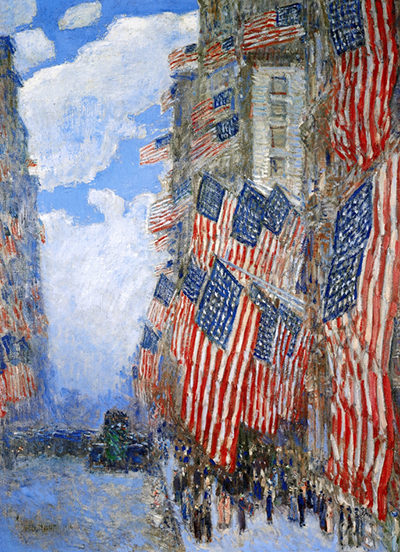This painting is about as patriotic as it gets, and its creator, Childe Hassam, was highly passionate about his native country. He produced a series of flag paintings in which streets are decorated from head to toe in their national colours and these are amongst his most well known works.
The Fourth of July, 1916 features the stars and stripes adorning the two sides of a major road, dwarfing the residents below. The Impressionist approach would often incorporate blurred detail, where one is only given an 'impression' of the detail and this approach slowly gained acceptance within Europe before the ideas spread elsewhere. Hassam was an important figure who convinced Americans of the qualities of this groundbreaking approach and over time he was able to sell large numbers of works across the country. He essentially took the best qualities of the movement and combined it with some of the unique aspects of American life, be it the architecture, the landscape or whatever else. Between the years of 1916-1919 he produced this series of flag paintings which covered both the period in which the US joined WWI but also the celebrations that occurred after the war was won. He would have been proud to see France defended successfully, having becoming so fond of its culture after living and travelling there several times across his lifetime.
Within the French Impressionist movement, it was Monet and Pissarro who frequently captured city life. They noticed how things were becoming busier and more frenetic, and found it necessary to return to nature fairly regularly in order to offset this growing stress. Perhaps their views of industrialisation and the movement of populations from rural areas into the cities was not overly complementary, but Hassam by contrast saw this change in a more positive light. He saw a growing economic strength across the US and whilst his artistic style was similar to theirs, his emotions within the cityscapes was a little different. He was, after all, an American who took on their technical methods but combined it with a slightly different culture and history, inevitably leading to an alternative approach which also had to be tailored to a different audience in any case. Today we regard The Fourth of July, 1916 as one of his most memorable paintings of all.
Some of the other examples from his flag series include the likes of Allies Day, May 1917 and The Avenue in the Rain. This content proved popular and the artist also liked the fact that he was capturing historic moments within these paintings. There were also technical challenges within these works, with his handling of architecture being a key skill for these works, alongside light, weather and drapery in how the flags moved and flickered in the wind. He would always experiment with different conditions, and rain offered an opportunity to apply brushwork in an alternative manner which was an idea he had also learnt from his French counterparts. This patriotic artist tapped into the likeminded public who were immediately drawn to his proud artworks, even as the styles of the Impressionists was still gained traction across the country.




